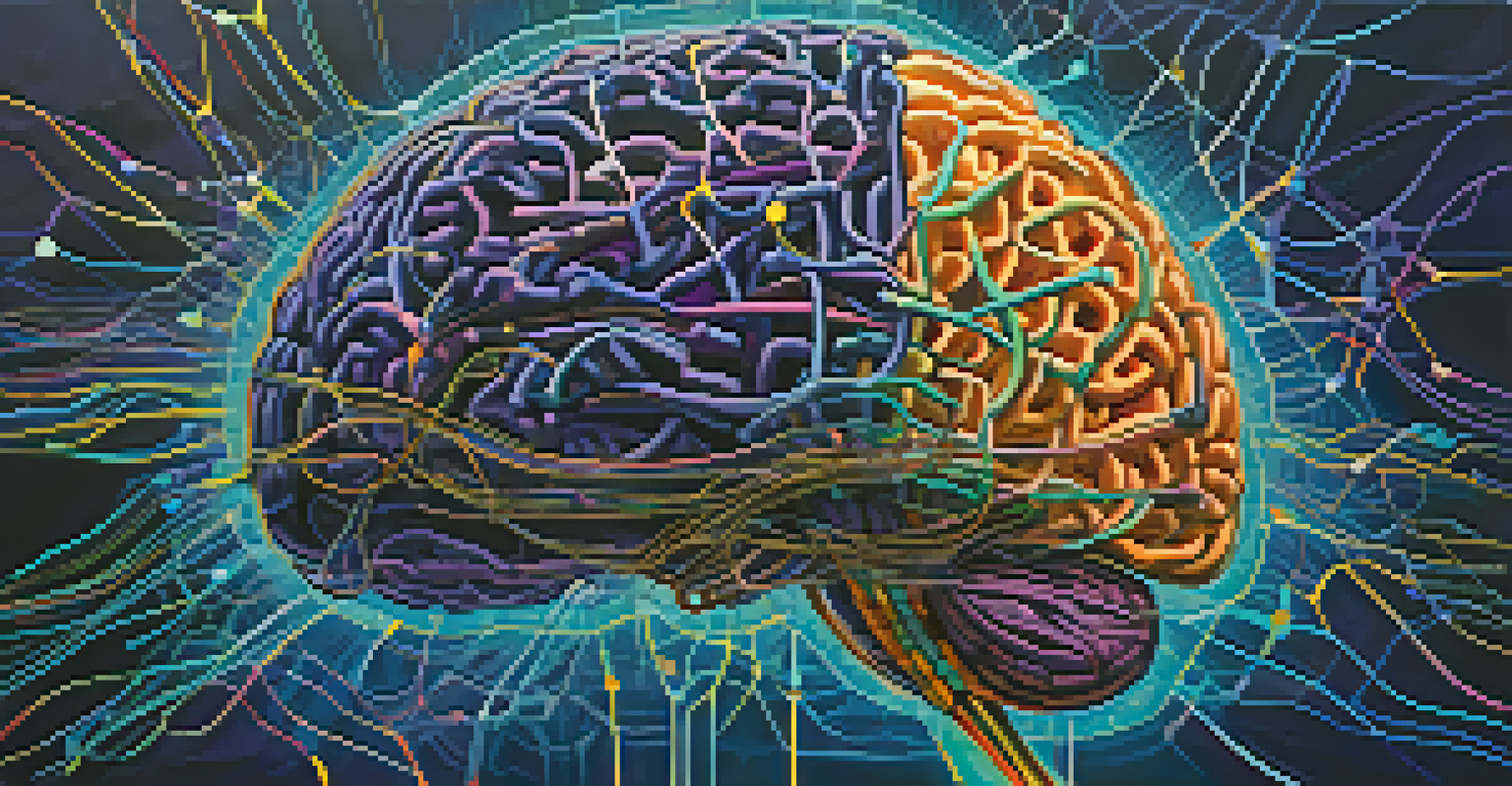Understanding the DMN: Effects of Psychedelics and Entheogens

What is the Default Mode Network (DMN)?
The Default Mode Network (DMN) is a network of brain regions that show increased activity during rest and daydreaming. Think of it as your mind's background chatter, where thoughts about the past, future, and self-reflection occur. This network is crucial for our sense of identity and personal narrative, allowing us to process experiences and emotions. Understanding the DMN helps us appreciate how various substances can alter our mental states.
Psychedelics can open doors to the deeper parts of ourselves that we may not have known existed.
Researchers have identified several key areas that make up the DMN, including the medial prefrontal cortex and the posterior cingulate cortex. These regions work together to facilitate internal dialogue and self-related thinking. When we engage in creative thinking or reminisce about past events, this network is hard at work. This makes the DMN an interesting target for studying the effects of psychedelics.
In essence, the DMN is like the stage where our internal thoughts play out. Just as an actor's performance can change the mood of a play, substances like psychedelics can dramatically influence how this network operates. By exploring this connection, we can gain insight into our consciousness and the role of psychedelics in shaping our mental landscapes.
How Psychedelics Affect the DMN
Psychedelics like psilocybin and LSD are known to alter the functioning of the DMN. Research indicates that these substances can reduce the activity of the DMN, leading to a decreased sense of ego and self. Imagine the DMN as a busy highway; psychedelics often create detours that allow for new routes of thought and perception. This shift can result in profound experiences of interconnectedness and unity.

When the DMN's activity is dampened, individuals often report feeling less constrained by their usual patterns of thinking. This phenomenon can lead to what many describe as a 'mystical experience,' where the boundaries of self dissolve. In practical terms, this means that thoughts that typically evoke anxiety or fear may lose their grip, allowing for a fresh perspective on life. The implications of this are vast, especially in therapeutic contexts.
DMN: The Mind's Internal Narrative
The Default Mode Network (DMN) is a brain network active during rest and daydreaming, crucial for self-reflection and identity.
Moreover, studies have shown that reducing DMN activity can enhance creative thinking and problem-solving abilities. Picture a painter who suddenly sees the world in a new light, free from the constraints of traditional techniques. Psychedelics can unlock similar creative potentials in the mind, offering new insights and a deeper understanding of personal challenges.
Entheogens and Their Role in Spiritual Experiences
Entheogens, which include substances like ayahuasca and peyote, are often used in spiritual and religious contexts. These natural substances can lead to experiences that feel transcendent and deeply meaningful. For many, consuming entheogens is akin to embarking on a spiritual journey, where the DMN plays a crucial role in shaping the experience. The insights gained during these journeys often influence personal beliefs and life paths.
The mind is not a vessel to be filled, but a fire to be kindled.
The interaction between entheogens and the DMN can facilitate profound insights about existence and our place in the universe. Participants in guided ceremonies often report experiencing a sense of unity with nature and a connection to something greater than themselves. These moments can foster a deep sense of peace and purpose, making the experience highly transformative.
Additionally, entheogenic experiences can help individuals confront and process unresolved trauma. Just as a skilled therapist helps a client delve into painful memories, entheogens can open pathways to face these issues with a fresh perspective. This therapeutic potential highlights the importance of understanding how the DMN operates under the influence of entheogens.
The Therapeutic Potential of Psychedelics
The therapeutic applications of psychedelics have gained traction in recent years, particularly for mental health conditions like depression and PTSD. By influencing the DMN, psychedelics can help break negative thought patterns and facilitate new ways of thinking. Imagine being stuck in a maze; psychedelics can provide a new vantage point, allowing you to find an exit you never knew existed.
Clinical studies suggest that psychedelics can lead to lasting changes in mood and perspective, often after just a few sessions. For many participants, these experiences result in significant reductions in symptoms and an increased sense of well-being. The potential for psychedelics to serve as adjuncts to traditional therapies is an area of ongoing research, with promising results already emerging.
Psychedelics Transform Thought Patterns
Psychedelics can reduce DMN activity, leading to decreased ego and enhanced creativity, often resulting in profound personal insights.
Moreover, the ability of psychedelics to enhance emotional openness can improve the therapeutic alliance between patients and therapists. This shift can create a more conducive environment for healing and personal growth. As we continue to explore the relationship between psychedelics and the DMN, the future of mental health treatment looks increasingly hopeful.
Risks and Considerations of Psychedelic Use
Despite their potential benefits, the use of psychedelics is not without risks. Individual reactions can vary widely, and not everyone may experience positive outcomes. Factors like dosage, set (mindset), and setting (environment) can greatly influence the experience. It's essential to approach these substances with caution and respect, much like navigating a river with strong currents.
Some individuals may encounter challenging experiences, often termed 'bad trips.' These moments can evoke feelings of fear or anxiety, particularly if one feels overwhelmed by the experience. Understanding the role of the DMN in these situations is crucial, as heightened activity may lead to increased feelings of ego dissolution and loss of control. Having a supportive guide during such experiences can help mitigate these risks.
Additionally, individuals with a history of mental health issues should exercise particular caution when considering psychedelics. The effects on the DMN can sometimes exacerbate underlying conditions, making it vital to consult with a professional. Awareness and preparation can significantly impact the safety and efficacy of using psychedelics for personal growth or therapeutic purposes.
The Future of Psychedelic Research
As interest in psychedelics continues to grow, so does the need for rigorous scientific research. Understanding how these substances interact with the DMN is essential for unlocking their full potential. The future of psychedelic research could lead to groundbreaking discoveries in both mental health treatment and our understanding of consciousness itself. Just as the exploration of space has expanded our view of the universe, psychedelic research may broaden our understanding of the human mind.
Innovative studies are already underway, exploring the effects of various psychedelics on the DMN and overall brain functioning. These studies aim to clarify the mechanisms behind the therapeutic benefits of psychedelics and how they can be integrated into modern medicine. As we delve deeper into this field, the hope is that psychedelics can become valuable tools in addressing mental health challenges.
Therapeutic Potential of Psychedelics
Research suggests psychedelics offer therapeutic benefits for mental health conditions by breaking negative thought patterns and fostering emotional openness.
Ultimately, the future of psychedelic research is not just about unlocking new therapies; it's also about understanding the profound implications these substances have on our perception of reality and self. By studying the DMN and its interplay with psychedelics, we can uncover insights that may reshape our approach to consciousness and well-being.
Conclusion: Embracing the Exploration
In conclusion, understanding the DMN and its relationship with psychedelics and entheogens invites us into a fascinating world of exploration. The insights gained from this journey can inform not only therapeutic practices but also our understanding of what it means to be human. As we continue to embrace the exploration of consciousness through these substances, we open ourselves to new possibilities for healing and growth.
While we tread carefully on this path, it's essential to maintain an open mind and heart. The experiences facilitated by psychedelics can lead to profound shifts in perspective and understanding, reshaping our lives in meaningful ways. Just as each person's journey is unique, so too are the insights gained from these experiences.

As we look toward the future, fostering a respectful dialogue around psychedelics and their effects on the DMN will be crucial. With continued research and open-mindedness, we may unlock the potential for transformative experiences that can benefit individuals and society as a whole.